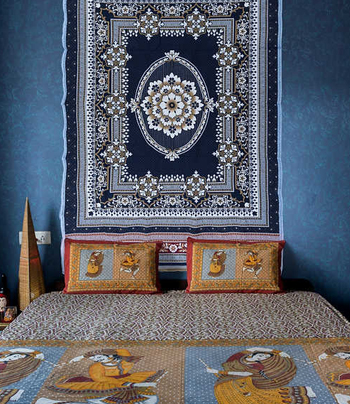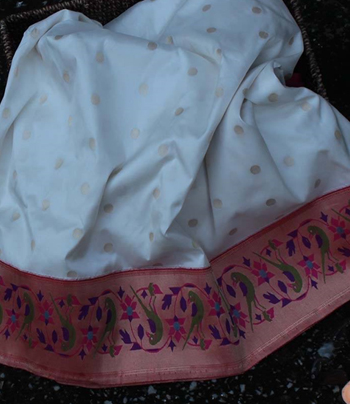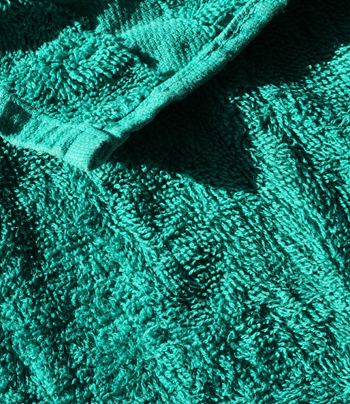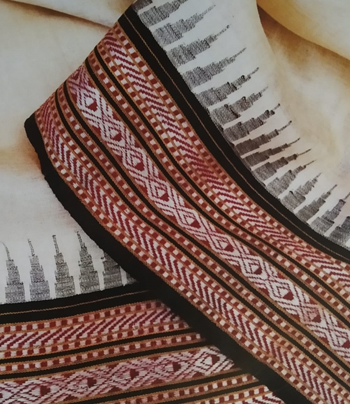Solapur Chaddar
A Solapur chaddar, is a cotton blanket made in the Solapur city of the Indian state of Maharashtra.These blankets are popular in India where they are manufactured, previously by hand loom but now by Jacquard machine and are known for their unique design and durability.Solapuri chaddars were the first product of Solapur, in Maharashtra, to obtain Geographical Indication (GI) status. Solapur is known for its textile industry. Once it had Asia's largest spinning mills.The development of the handloom weaving industry in Solapur seems to have commenced during the regime of the Peshwas. There were numerous small independent artisan weavers in the industry. Each artisan-house had one or two looms which were generally handled by the head of the family. The family was the unit of work and the women and the children helped the weaver in preparatory processes and in some cases in dyeing also. The rise of the modern factory in India in the 1970s altered the organisation of the local hand-loom weaving industry. They have been manufactured by Padmashali weavers from South India since their presence in Solapur in the 1950s. Many companies manufacture chaddars in Solapur district. Apart from Maharashtra, Solapuri Chaddar has demand in Karnataka, Telangana, Andhra Pradesh, Madhya Pradesh, Gujarat, Rajasthan within India, while it also has demand in United Arab Emirates, Kuwait, South Africa, United States, United Kingdom and Canada.
Paithani Sarees And Fabrics
It is only from the 6th Century BC, that we have more definite historical evidence about the crafts of Paithan. Only with the coming of the Satavahanas, however, does some kind of real recorded and detailed history of Paithan become possible. A range of products are being produced by the weavers of this weaving centre. The products are Paithani sarees, Stoles, Napkin, Bed sheet, Pillow cover, Cushion cover, Door screen, Wall hangings, Ladies Dress Material(LDM) and Table cloth etc., are manufactured which are unique in its own way. Paithani sari is characterised by borders of an oblique square design and a pallu with a peacock design. The design framework is linear and exquisite, enamelled floral birds especially the peacock and parrot / maina forms are woven in gold on the "Pallav and Border". The back and face of the sari is very similar as it is woven in tapestry method. The jari used in the sari is on silk thread with twisted silver coated with gold. Sometimes cotton thread with twisted zari is used. In the Pallu of such saris, certain motifs are very commonly found. Some of them are 'Asawali', 'Panja' (a flower in a geometrical shape), 'Muthada' (a geometrical shape), and 'Mor' (peacock). Paithani saris are woven in a number of colors. The very delicate colors of the Paithani silk saris give it a unique touch these colors can be pure or be created using a blend of different colored yarns. .
Solapur Terry Towel
Solapur Terry Towel is terry towel weaving or knitting work that are manufactured in the Solapur district of Maharashtra state, India. The terry towel work has been protected under the Geographical indication (GI) of the Agreement on Trade-Related Aspects of Intellectual Property Rights (TRIPS) agreement. It is listed at item 9 as "Solapur Terry Towel" of the GI Act 1999 of the Government of India with registration confirmed by the Controller General of Patents Designs and Trademarks. Solapur Terry Towel has unique design and it has global market. Also, it is allied production of Solapuri chaddar. The handicraft work gives livelihood assistance to nearly 200,000 people in Solapur district. Terry towel made by cotton yarn.
Karvath Kati Tussar Sarees And Fabrics
The Karvath Kati Sarees & Fabrics is socio-culturally associated with the people of Maharashtra it is an auspicious wear for various religious occasions in Vidharbha region. The Vidharbha region of Maharashtra is the originating place of Karvat Kati (saw-edged) saree so named after the border design which resembles saw teeth. The design resembling saw teeth is weaved on body part of the saree at both the sides adjacent to the border. Every karvath kati design saree will have this pattern of design on both the sides. The root origin of most of the designs is the sculptures seen at the famous Ramtek temple, which is near to this place. A range of products are being produced by the weavers of this weaving centre. The products are Karvath Kati sarees, Shirting, and Ladies Dress Material (LDM) etc., are manufactured which are unique in its own way. The major products produced in the cluster are Saree, Shirting, Ladies Dress Material, Dupatta for Gents and Ladies and also Stole. The Sarees are of length 6.5 mtrs and width 50'. The count of the yarn used as Warp is 35 D Korea Silk for all the products except Stole. For Stoles, the count of the yarn used in the Warp is 36 D Korea Silk. The count of the yarn used in the Weft of the Saree ranges from 50-70 D Silk of local variety. The reed of the Saree is 72" and picks varies from 66 to 72. The width of Saree, Shirting, Ladies Dress Material are 50'. The warp yarn for shirting is 35 D Korea Silk whereas the commonly used weft yarn are "Cotton-1/100s, 1/80s", "Pedenkal Yarn – 60 D", "China Silk- Mulberry", "Moga", "Ghicha", and "Tussar Silk". The reed for Shirting varies from 72-80 and the picks varies from 30 to 80. The commonly used yarn in the weft of the Ladies Dress Material are Cotton-1/100s, 1/80s", "Pedenkal Yarn – 60 D", "China Silk- Mulberry", "Moga", "Ghicha", and "Tussar Silk". The reed of the fabric produced ranges from 72-80 and the picks varies from 30 to 80. The yarn used in the weft for "Gents Dupatta" & "Ladies Dupatta" are "Cotton-1/100s, 1/80s", "Pedenkal Yarn – 60 D", "China Silk- Mulberry", "Moga", "Ghicha", and "Tussar Silk". The reed is 72 and picks are in the range 50-55. For stoles, Tussar Silk is used in the weft. The reed for stoles is 72 and picks are in the range 45-50. The width of the stoles are 24', 30' and 50'.







